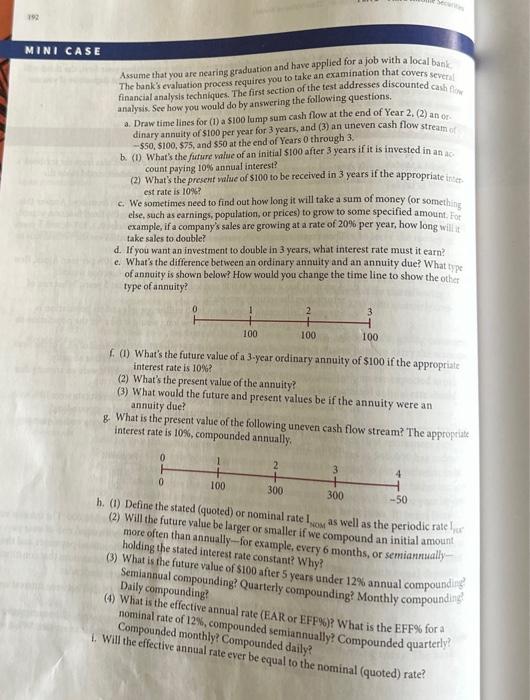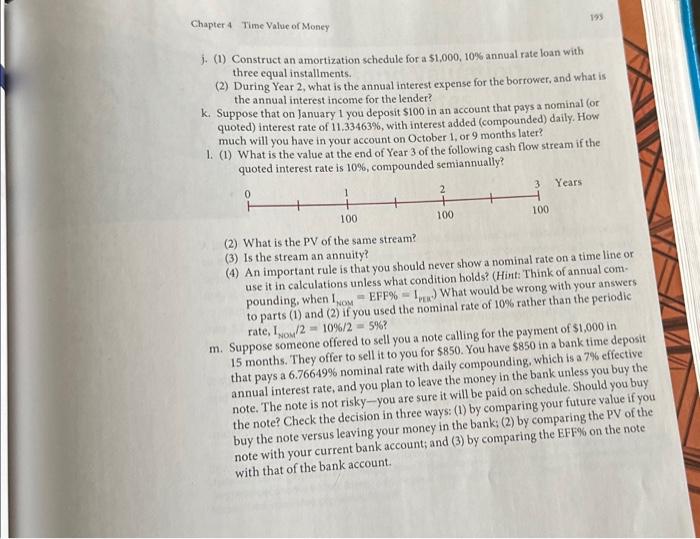Steps & excel formulas
J- M
S E Assume that you are nearing graduation and have applied for a job with a local bank, The bank's evaluation process requires you to take an examination that covers several. financial analysis techniques. The first section of the test addresses discounted cash flown analysis. See how you would do by answering the following questions. a. Draw time lines for (1) a s100 lamp sum cash flow at the end of Year 2, (2) an or. dinary annuity of $100 per year for 3 years, and (3) an uneven cash flow stream of $50,$100,$75, and $50 at the end of Years 0 through 3 . b. (1) What's the future walue of an initial $100 after 3 years if it is invested in an acc count paying 10% annual interest? (2) What's the present value of $100 to be received in 3 years if the appropriate inted est rate is 100 ? c. We sometimes need to find out how long it will take a sum of money (or something, else, such as earnings, population, or prices) to grow to some specified amount. For example, if a company's sales are growing at a rate of 20% per year, how long will it. take sales to double? d. If you want an investment to double in 3 years, what interest rate must it earn? c. What's the difference between an ordinary annuity and an annuity due? What type of annuity is shown below? How would you change the time line to show the other type of annuity? f. (1) What's the future value of a 3 -year ordinary annuity of $100 if the appropriaic interest rate is 10% ? (2) What's the present value of the annuity? (3) What would the future and present values be if the annuity were an annuity due? 8. What is the present value of the following uneven cash flow stream? The approprite interest rate is 10%, compounded annually, h. (1) Defueme stated (quoted) or nominal rate I rom as well as the periodic rate I (2) Will the future value be larger or smaller if we compound an initial amount more often than annually-for example, every 6 months, or semianmuallyholding the stated interest rate constant? Why? (3) What is the future value of $100 after 5 years under 12% annual compounding? Semiannual compounding? Quarterly compounding? Monthly compounding? Daily compounding? (4) What is the effective annual rate (EARR or EFF\%)? What is the EFF\% for a nominal rate of 12%, compounded semiannually? Compounded quarterly? Compounded monthly? Compounded daily? 1. Will the effective annual rate ever be equal to the nominal (quoted) rate? j. (1) Construct an amortization schedule for a $1,000,10% annual rate loan with three equal installments. (2) During Year 2, what is the annual interest expense for the borrower, and what is the annual interest income for the lender? k. Suppose that on January 1 you deposit $100 in an account that pays a nominal (ot quoted) interest rate of 11,33463%, with interest added (compounded) daily. How much will you have in your account on October 1 , or 9 months later? 1. (1) What is the value at the end of Year 3 of the following cash flow stream if the quoted interest rate is 10%, compounded semiannually? (2) What is the PV of the same stream? (3) Is the stream an annuity? (4) An important rule is that you should never show a nominal rate on a time line or use it in calculations unless what condition holds? (Hint: Think of annual compounding, when INoM= EFF\% =1ved. What would be wrong with your answers to parts (1) and (2) if you used the nominal rate of 10% rather than the periodic rate, INou/2=10%/2=5% ? m. Suppose someone offered to sell you a note calling for the payment of $1,000in 15 months. They offer to sell it to you for $850. You have $850 in a bank time deposit that pays a 6.76649% nominal rate with daily compounding, which is a 7% effective annual interest rate, and you plan to leave the money in the bank unless you buy the note. The note is not risky-you are sure it will be paid on schedule. Should you buy the note? Check the decision in three ways: (1) by comparing your future value if you buy the note versus leaving your money in the bank; (2) by comparing the PV of the note with your current bank account; and (3) by comparing the EFF on the note with that of the bank account








